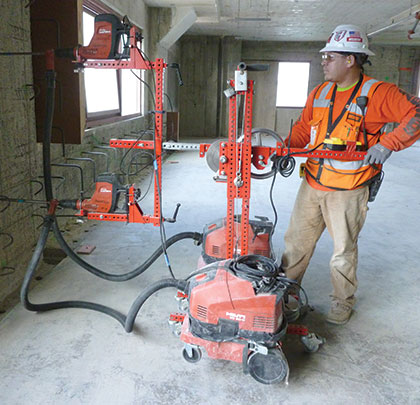Long known as a hub of innovation, San Francisco will soon be home to the Bay Area Headquarters Authority (BAHA)—a collaborative of local agencies, as well as office and retail space, housed in the city’s SOMA district. The 8-story building, which originally housed a tank manufacturer, features 12-inch thick concrete walls and slabs. Large sections of the building’s interior were gutted for modernization and to create a new atrium.
To meet seismic standards, and to accommodate the changes to the building’s internal structure, the building required a seismic upgrade that involved drilling more than 27,000 holes into the interior concrete walls and floor. Dowels were epoxied into the holes, rebar was added, and a new layer of shotcrete (12 to 24 inches, depending on the location) was applied for greater support.
McCarthy Building Companies, Inc.—contracted to perform the retrofit—immediately recognized the risk associated with this effort, and determined the safest and most effective way to drill the thousands of holes into the existing concrete. The solution: an innovative combination of a dual-headed drill rig designed by a team at the University of California (San Francisco and Berkeley campuses) and a Hilti drilling system that reduced worker fatigue, improved productivity, and minimized the amount of airborne concrete dust created in the drilling process.
LESS CLEANING, LESS EXPOSURE
Drilling holes for dowels in concrete reinforcement is a dirty process that ejects concrete dust (including potentially harmful silicates) into the work environment, and requires cleaning the holes before applying the epoxy and inserting the dowels. That cleaning process is almost as time consuming as the drilling itself and is a major drag on productivity, especially when you extrapolate that out over more than 27,000 holes.
To reduce cleaning time—and to capture the ejected concrete dust at the source—McCarthy equipped its crews with 16 Hilti HIT-HY 200 Systems with Safe Set™ Technology, which indicates that an adhesive anchor is approved for installation using Hilti’s innovative non-cleaning system. Each system consisted of a TE-50 combihammer, a VC20 vacuum, and TE-YD hollow drill bits. The hollow drill bits and vacuum immediately suck the pulverized concrete dust out of the hole and provide the greatest efficiency: no cleaning and an almost dustless work environment.
“The biggest thing that did for us was that we didn’t have to clean the hole,” says Jody Kelly, project superintendent for McCarthy. “In normal processes, we use a wire brush and compressed air [to clean out the holes]. We were able to drill the holes, and as long as we put the epoxy down within 4 days, we did not have to clean, which saves a lot on labor.”
“Normally there would be … drilling the holes, cleaning the holes, epoxying the holes. We took the middle one out, so I would say the whole process saved us a third of the time,” he adds.
The system further simplifies cleanup and disposal of the concrete dust by placing it directly in the vacuum cleaner’s collection bin—and that’s another major benefit: it reduces exposure of the workers to concrete dust and the potentially hazardous silicates it contains. After implementation of the systems, an occupational hygienist tested the site and found that the exposure to silica dust was below the required threshold for respirators; some workers still wore particle masks as a precaution.
“Using a normal tool that doesn’t have the [hollow drill bits] and vacuum attachment, the silicate [comes] out of the hole and creates a dust cloud,” says Kelly. “In this case, with the vacuums, it completely took care of that for us. We didn’t have that hazard.”
TAKING A LOAD OFF
Another concern was the repetitive nature of the task and the toll it would take on the workers to drill thousands of holes into the building’s structure. To address this, McCarthy incorporated a two-headed rig with fixtures for two Hilti combihammers and vacuum hoses to allow one worker to drill two holes at a time.
Teams from UC San Francisco and Berkeley designed the rig, altered slightly by the team at McCarthy to meet the demands of the job.
“One [concern] was the repetitive motion of the guy who is holding the drill,” says Kelly. “The vibration and the impact of the hammering on the wall—the machine was designed to do that for us. Our workers aren’t holding up the drills to do the drilling, they’re merely positioning the machine where they want to drill the hole.”
“We had guys that would do 100, 150 holes a day, and there was literally no fatigue.”
McCarthy project director Ranjit Sinha sees the intangible safety benefits the system brought to the project.
“This was ultimately to reduce any risk to the trades,” he says. “We didn’t go into this saying we [were going to prevent] four back strains and three repetitive motion carpal tunnel [injuries]. Ultimately we had zero accidents out there, and that would be our goal even if we hadn’t done it.”
That commitment to safety is both good for workers and the company’s bottom line. Sinha sees the combination of the new drilling system and the steadfast focus on safety by the crew as the ultimate team effort that drove success for McCarthy on this project.
“To walk out of here with no injuries on a job that had this many man hours associated with it and a fairly intense restricted work environment is really just a testament to the guys out there,” Sinha adds. ■
For More Information: Founded 150 years ago as a family business, McCarthy Building Companies, Inc. is now entirely employee owned. McCarthy’s mission is to be The Best Builder in America, believing that being a builder first makes all the difference. For more information, visit www.mccarthy.com.
_________________________________________________________________________
Modern Contractor Solutions, July 2015
Did you enjoy this article?
Subscribe to the FREE Digital Edition of Modern Contractor Solutions magazine.



